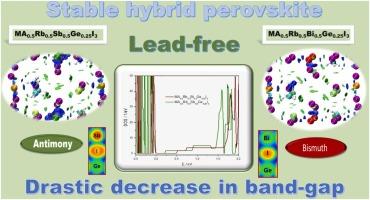无铅杂化钙钛矿:MA0.5Rb0.5Bi0.5Ge0.25I3和MA0.5Rb0.5Sb0.5Ge0.25I3的结构和电子分析
IF 6.3
2区 材料科学
Q2 CHEMISTRY, PHYSICAL
引用次数: 0
摘要
研究了MA0.5Rb0.5Bi0.5Ge0.25I3和MA0.5Rb0.5Sb0.5Ge0.25I3无铅杂化钙钛矿的结构和电子稳定性。由于铅在MAPbI3钙钛矿中的毒性和稳定性,在环境友好型太阳能电池的设计中引起了越来越多的科学关注。用50%的Rb+取代MA阳离子(CH3NH3+),提高了稳定性并保持了有机特性。研究了铅在MA0.5Rb0.5PbI3结构中的取代作用。对于Ge含量为75%和100%的结构,电子局域化函数(ELF)分析显示,没有电子局域化的区域表明了一定程度的结构不稳定性。含50% Ge的MA0.5Rb0.5Pb0.5Ge0.5I3结构的ELF和态密度(DOS)分析证实了该钙钛矿的稳定性。因此,我们选择MA0.5Rb0.5Pb0.5Ge0.5I3结构作为Bi和Sb取代铅的结构。ELF和非共价指数(NCI)分析表明,Sb结构比Bi结构更稳定。Bi和Sb的存在分别大大减小了MA0.5Rb0.5Bi0.5Ge0.25I3和MA0.5Rb0.5Sb0.5Ge0.25I3结构中的带隙,这使得这两种结构在光伏器件中都有应用的兴趣。这些发现为设计稳定的无铅钙钛矿提供了一条途径,并改善了下一代太阳能电池的光电性能。本文章由计算机程序翻译,如有差异,请以英文原文为准。

Lead-Free Hybrid Perovskites: Structural and Electronic Analysis of MA0.5Rb0.5Bi0.5Ge0.25I3 and MA0.5Rb0.5Sb0.5Ge0.25I3
Structural and electronic stability of MA0.5Rb0.5Bi0.5Ge0.25I3 and MA0.5Rb0.5Sb0.5Ge0.25I3 lead-free hybrid perovskites is addressed. The substitution of Pb in MAPbI3 perovskite is increasing the scientific attention due to its toxicity as well as stability of interest in the design of environmentally friendly solar cells. MA cation (CH3NH3+) is replaced by 50% Rb+ to improve stability and retain the organic characteristics. The substitution of lead in MA0.5Rb0.5PbI3 structure has been studied up to 100% Ge. Electron localization function (ELF) analysis for structures with 75 and 100% of Ge, show zones with no electron localization that indicates certain degree of structural instability. ELF and density of states (DOS) analysis of the structure MA0.5Rb0.5Pb0.5Ge0.5I3 with 50% Ge corroborate stability characteristics of this perovskite. Thus, the MA0.5Rb0.5Pb0.5Ge0.5I3 structure has been selected for the substitution of lead by Bi and Sb. ELF and non-covalent index (NCI) analysis indicate Sb structures are slightly more stable than those with Bi. The presence of Bi and Sb drastically decreases the band-gap in the MA0.5Rb0.5Bi0.5Ge0.25I3 and MA0.5Rb0.5Sb0.5Ge0.25I3 structures, respectively, which makes both structures without lead of interest for use in photovoltaic devices. These findings provide a pathway for designing stable, lead-free perovskites with improved optoelectronic properties for next-generation solar cells.
求助全文
通过发布文献求助,成功后即可免费获取论文全文。
去求助
来源期刊

Journal of Alloys and Compounds
工程技术-材料科学:综合
CiteScore
11.10
自引率
14.50%
发文量
5146
审稿时长
67 days
期刊介绍:
The Journal of Alloys and Compounds is intended to serve as an international medium for the publication of work on solid materials comprising compounds as well as alloys. Its great strength lies in the diversity of discipline which it encompasses, drawing together results from materials science, solid-state chemistry and physics.
 求助内容:
求助内容: 应助结果提醒方式:
应助结果提醒方式:


